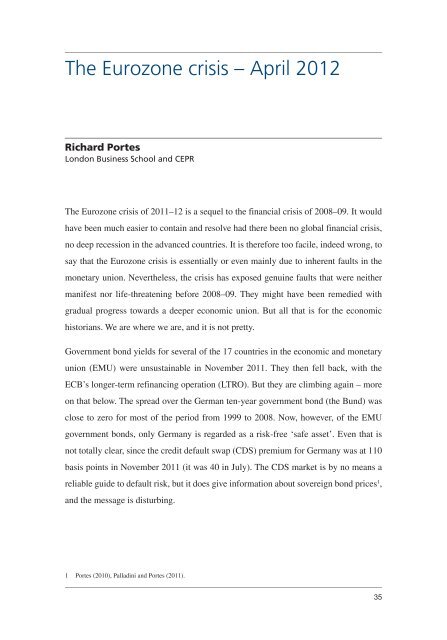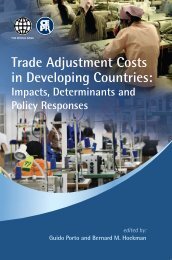- Page 1: Rethinking Global EconomicGovernanc
- Page 5 and 6: Centre for Economic Policy Research
- Page 7 and 8: How to prevent and better handle th
- Page 12 and 13: IntroductionThe PEGGED Research Pro
- Page 14 and 15: Introductionsay that the Eurozone c
- Page 16 and 17: IntroductionGlobalisation, financia
- Page 18 and 19: Introductionrather than disentangli
- Page 20 and 21: Introductionbase in one connect the
- Page 22 and 23: Introductiondraconian immigration r
- Page 24: IntroductionAbout the authorsRichar
- Page 27 and 28: Rethinking Global Economic Governan
- Page 29 and 30: Rethinking Global Economic Governan
- Page 31 and 32: Rethinking Global Economic Governan
- Page 33 and 34: Rethinking Global Economic Governan
- Page 36 and 37: Fiscal consolidation andmacroeconom
- Page 38 and 39: Fiscal consolidation and macroecono
- Page 40 and 41: Fiscal consolidation and macroecono
- Page 42 and 43: Fiscal consolidation and macroecono
- Page 46 and 47: The Eurozone crisis - April 2012is
- Page 48 and 49: The Eurozone crisis - April 2012Com
- Page 50 and 51: The Eurozone crisis - April 2012The
- Page 52 and 53: The Eurozone crisis - April 2012ind
- Page 54 and 55: The Eurozone crisis - April 2012not
- Page 56 and 57: The Triffin Dilemma and a multipola
- Page 58: The Triffin Dilemma and a multipola
- Page 61 and 62: Rethinking Global Economic Governan
- Page 63 and 64: Rethinking Global Economic Governan
- Page 66 and 67: Financial stability: Where it went
- Page 68 and 69: Financial stability: Where it went
- Page 71 and 72: Rethinking Global Economic Governan
- Page 73 and 74: Rethinking Global Economic Governan
- Page 75 and 76: Rethinking Global Economic Governan
- Page 77 and 78: Rethinking Global Economic Governan
- Page 79 and 80: Rethinking Global Economic Governan
- Page 81 and 82: Rethinking Global Economic Governan
- Page 84 and 85: How to prevent and better handlethe
- Page 86 and 87: Failures of global systemically imp
- Page 88 and 89: Failures of global systemically imp
- Page 90 and 91: Failures of global systemically imp
- Page 92: Failures of global systemically imp
- Page 95 and 96:
Rethinking Global Economic Governan
- Page 97 and 98:
Rethinking Global Economic Governan
- Page 99 and 100:
Rethinking Global Economic Governan
- Page 101 and 102:
Rethinking Global Economic Governan
- Page 103 and 104:
Rethinking Global Economic Governan
- Page 105 and 106:
Rethinking Global Economic Governan
- Page 107 and 108:
Rethinking Global Economic Governan
- Page 109 and 110:
Rethinking Global Economic Governan
- Page 111 and 112:
Rethinking Global Economic Governan
- Page 113 and 114:
Rethinking Global Economic Governan
- Page 116 and 117:
Global banks, fiscal policy andinte
- Page 118 and 119:
Global bBanks, fiscal policy and in
- Page 120 and 121:
The Doha Round impasseSimon J Evene
- Page 122 and 123:
The Doha Round impasseAll too often
- Page 124 and 125:
The Doha Round impasseWhy can’t t
- Page 126 and 127:
The Doha Round impassethese factors
- Page 128:
The Doha Round impasseAbout the aut
- Page 131 and 132:
Rethinking Global Economic Governan
- Page 133 and 134:
Rethinking Global Economic Governan
- Page 135 and 136:
Rethinking Global Economic Governan
- Page 137 and 138:
Rethinking Global Economic Governan
- Page 139 and 140:
Rethinking Global Economic Governan
- Page 141 and 142:
Rethinking Global Economic Governan
- Page 144 and 145:
Open to goods, closed to people?Pao
- Page 146 and 147:
Open to goods, closed to people?it
- Page 148 and 149:
Open to goods, closed to people?Ref
- Page 150:
Open to goods, closed to people?Uni
- Page 153 and 154:
Rethinking Global Economic Governan
- Page 155 and 156:
Rethinking Global Economic Governan
- Page 157 and 158:
Rethinking Global Economic Governan
- Page 159 and 160:
Rethinking Global Economic Governan
- Page 161 and 162:
Rethinking Global Economic Governan
- Page 163 and 164:
Rethinking Global Economic Governan
- Page 166 and 167:
A dangerous campaign:Why we shouldn
- Page 168 and 169:
A dangerous campagin: Why we should
- Page 170 and 171:
A dangerous campagin: Why we should
- Page 172 and 173:
A dangerous campagin: Why we should
- Page 174:
Rethinking global economic governan














